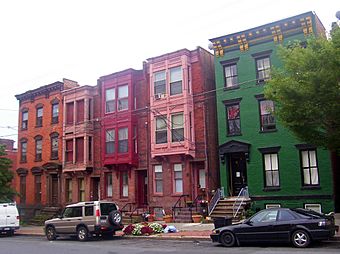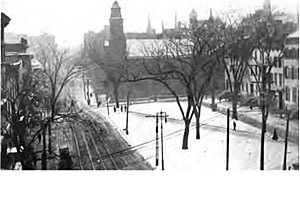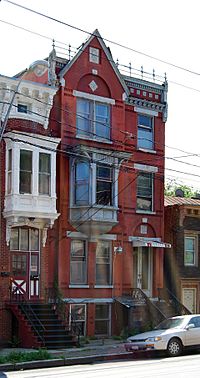Clinton Avenue Historic District (Albany, New York) facts for kids
Quick facts for kids |
|
|
Clinton Avenue Historic District
|
|

North elevations, 52-60 Clinton Avenue, 2008
|
|
| Location | Along Clinton Ave. from Quail to N. Pearl Sts., Albany, New York |
|---|---|
| Area | 70 acres (28 ha) |
| Built | 1820-1930 |
| Architect | Hoffman, Ernest; Et al. |
| Architectural style | Colonial Revival, Greek Revival, Late Victorian |
| NRHP reference No. | 88001445 |
| Added to NRHP | September 01, 1988 |
The Clinton Avenue Historic District is a special area in Albany, New York. It covers about 70 acres along Clinton Avenue, from North Pearl Street to Quail Street. This district also includes some nearby streets like Lark and Lexington. It's a place where many old buildings have been kept safe because they are important to history.
This area became important after the Erie Canal opened, which helped Albany grow. Famous writer Herman Melville even lived in one of the early houses here. Most of the buildings, about 92% of nearly 600, are old rowhouses built in the 1800s. These houses show different building styles, especially the Italianate style. Many were built for middle-class families. This district has the most rowhouses of its kind in Albany. Most of these buildings are called "contributing properties," meaning they add to the district's historical value.
In 1981, Albany recognized it as a historic district. Seven years later, in 1988, it was added to the National Register of Historic Places (NRHP). This means it's a nationally recognized historic place. The city has worked to keep the district in good shape, using special funds to help restore and protect these old buildings.
Contents
Exploring the Clinton Avenue Historic District
Where is the Historic District Located?
The Clinton Avenue Historic District stretches for about 1.5 miles along Clinton Avenue. This street starts near the Hudson River and gently rises up. It goes from the flat areas near the river to the higher parts of Albany's western neighborhoods. Clinton Avenue is wider than many other streets in Albany.
The district is just north of downtown Albany and the big state buildings at Empire State Plaza. Other historic areas, like Arbor Hill, are also nearby. The boundaries of the district carefully follow the property lines behind the houses on both sides of Clinton Avenue. Some parts of side streets are also included if they have similar historic homes.
What Kind of Buildings Will You See?
This 70-acre area is mostly built up with buildings, though there are a few empty lots. There are 576 buildings in total. Only 20 of these are "non-contributing," meaning they are newer buildings like supermarkets or gas stations that don't fit the historic look.
The other 556 buildings are "contributing properties." Most of these, 530 buildings, are two- or three-story brick rowhouses. These were built over more than a century and show many different architectural styles. Besides the rowhouses, you can also find historic churches, an old police station, two schools, and a theater.
A Look Back at Clinton Avenue's History
How Did Clinton Avenue Begin?
The story of Clinton Avenue shows how Albany grew over time. In 1686, when Albany got its first official charter from the British, the future Clinton Avenue was the city's northern border. It was first called Patroon Street. North of it were the lands of the van Rensselaer family.
In 1815, about a thousand people lived in this area, and it became part of Albany. That's when Patroon Street was renamed Clinton Avenue.

The area really started to grow after the Erie Canal was finished in 1825. The canal connected to the Hudson River in Albany, bringing more people and business. In 1829, a special area called Clinton Square was created at the intersection of Clinton and North Pearl streets. This small park was a big step for the city's growth north of downtown. The creation of Clinton Square marks the start of the district's development.
The 1800s: A Time of Growth and New Styles
In the 1830s, many old houses around Clinton Square were replaced. The first rowhouses were built, showing the popular Greek Revival style. Only two of these early houses, 3 and 5 Clinton Place, are still standing. Herman Melville lived in one of them in 1843. These rowhouses set the style for the rest of the district.
The arrival of railroads in the 1840s brought more growth. Tracks came into the city north of Clinton Avenue, bringing lumber from northern New York. This led to a building boom. The oldest rowhouses on Clinton Avenue, at 65-75, were built in 1845.
By the 1850s, more houses were built between North Pearl and Swan streets. These homes often had the Italianate style, with decorative brackets under the roof. This style was very popular for rowhouses on Clinton Avenue until 1880. Today, most of the rowhouses in the district are Italianate. For example, the houses at 133–143 Clinton were built in 1851, and the long row from 250–272 Clinton was built in the 1870s.
In the late 1800s, more land was added to Albany, including all of Clinton Avenue. A horsecar line was also added, making it easier to get to downtown. This made the area even more popular, and houses replaced old brickyards. Many of the new rowhouses were rented to workers and craftspeople moving into the area.
Builders started using new styles like Richardsonian Romanesque and Queen Anne in the 1880s. You can see Queen Anne style in houses with unique bay windows or projecting gables, like 168 Clinton Avenue. By the 1890s, most of the district was built up, so new construction slowed down.
The 1900s: A New Theater and Preservation Efforts
Since most of the district was already built by 1890, not many new styles appeared in the early 1900s. However, some public buildings were added, like the Classical Revival police station at 222 Pearl Street in 1911. The Palace Theatre opened in 1931 at Clinton and North Pearl, marking the end of the district's main period of growth.
After World War II, many people moved to the suburbs. Some parts of the Clinton Street area began to show signs of decline. However, the district was never completely torn down. In the late 1970s, the city started getting grants to help fix up the area. The city bought the Palace Theatre in 1969 and then named the Clinton-North Pearl area a historic district in 1981. This led to the district being listed on the National Register of Historic Places.
Clinton Avenue Today
Today, if someone wants to build something new or change an existing building in the district, they need approval from the city's Historic Resources Commission (HRC). This group of citizens cares about architecture and history.
While many parts of the district have been improved, some areas, especially west of Northern Boulevard, still need work. The city continues to seek funds to help restore abandoned rowhouses and make sure they remain affordable homes for people.
The oldest firehouse in Albany, built in 1874, is also located on Clinton Avenue at Ontario Street. In 2011, a loan helped a local developer begin plans to turn the old police station at 222 North Pearl into apartments, giving an old building a new purpose.
Images for kids
-
Clinton Square in 1913 looking south towards the First Church in Albany (Reformed).
-
Abandoned rowhouse showing signs of urban blight











